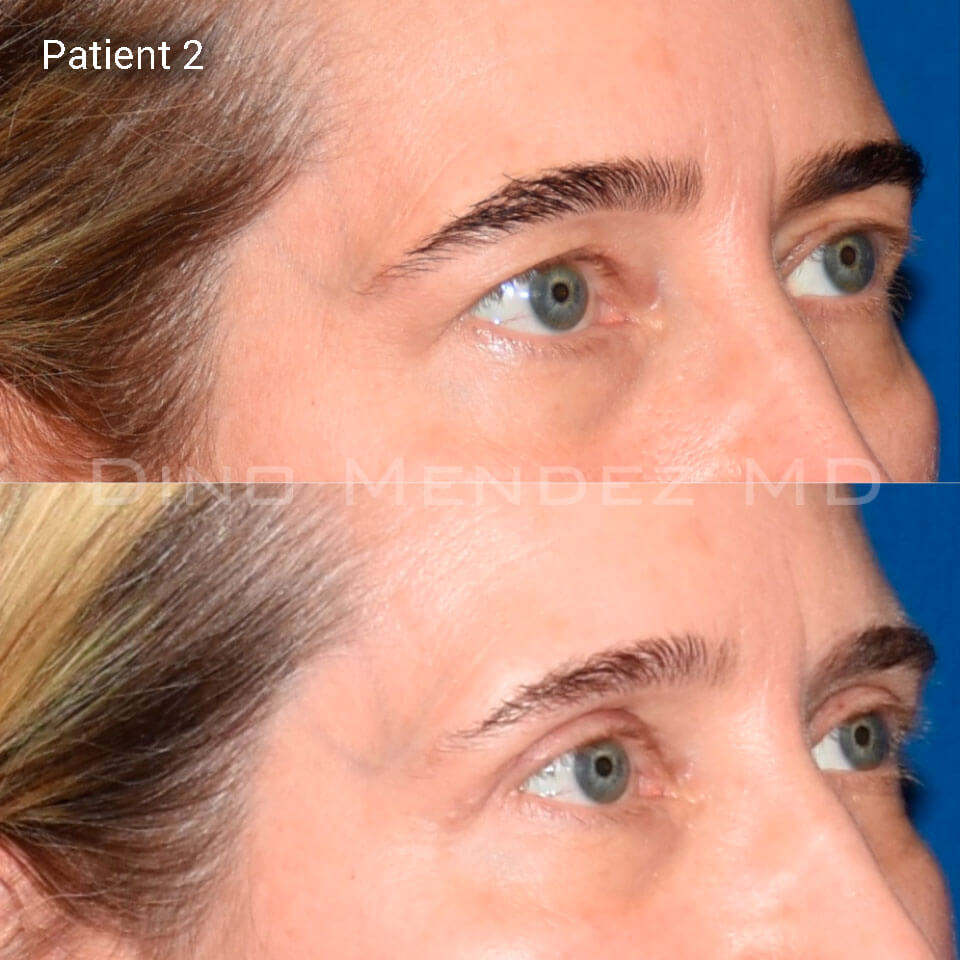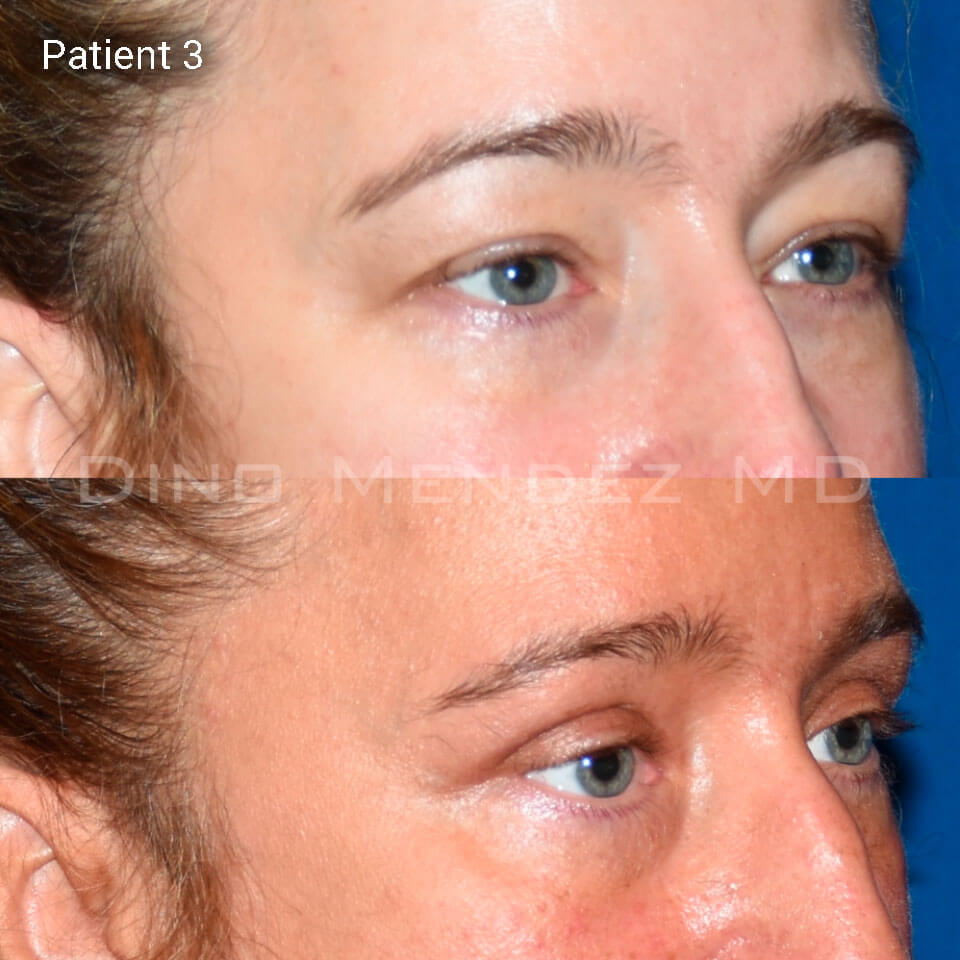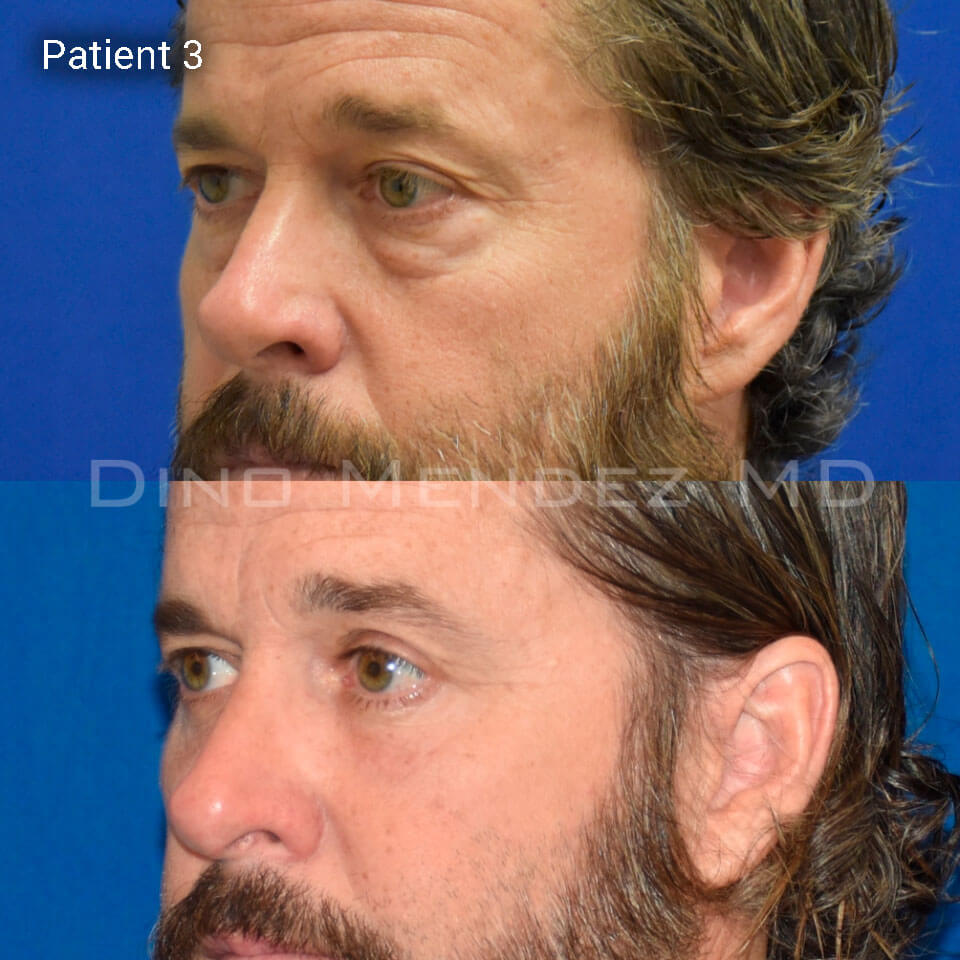Eyelid Surgery
An upper or lower eyelid surgery can address several issues, such as:
· Drooping or excessive skin
· Wrinkles
· Puffiness or bags under the eyes
· A desire for a more youthful eye appearance or better expressions



Eyelid Surgery Explained
Upper eyelid procedure
An incision is made in the natural crease of the upper eyelid. With this incision, excess eyelid skin is removed, and possibly some underlying fat, depending on the patient’s pre-operative exam. This helps restore a more youthful appearance to the upper eyelid by accentuating its natural curves and shape. By using the natural crease of your eyelid, this incision is very well concealed.
Lower eyelid procedure
Lower eyelid surgery can vary depending on the degree of aging. Two common complaints include lower lid skin excess and bulging fat, which can give patients a “tired” or “puffy” appearance. In the operating room, an incision is made either within your eyelid or at the lower lash line. Several surgical options are possible depending on the patient’s exam, including fat removal/repositioning, tissue tightening, and removal of excess skin.
The procedure aims to create a more alert, youthful, and refreshed appearance by addressing issues such as excess skin, wrinkles, and bulging fat around the eyes. Blepharoplasty is often chosen by individuals seeking to enhance their overall facial aesthetics and diminish signs of aging in the eye area.
Benefits of Eyelid Surgery
- Improved Aesthetic Appearance: The procedure reduces sagging skin, wrinkles, and puffiness, providing a more youthful and rejuvenated appearance to the eyes.
- Enhanced Peripheral Vision: In cases of severe upper eyelid sagging, blepharoplasty can lift the eyelids, improving the field of vision and alleviating obstruction.
- Reduced Under-Eye Bags: Lower eyelid surgery diminishes the appearance of under-eye bags and puffiness, contributing to a smoother and more rested look.
- Boost in Self-Confidence: Achieving a refreshed and revitalized eye area often leads to increased self-confidence and overall satisfaction with one's facial aesthetics.
- Long-Lasting Results: The results of eyelid surgery are long-lasting, providing enduring improvements to the contours and appearance of the eyes.
How Our Plastic Surgeons Can Help
Our experienced team is dedicated to guiding you through the process, ensuring your goals are understood and achieving the best results possible. Rediscover a more vibrant and revitalized gaze with Pinnacle Dermatology. Schedule your consultation now to embark on your journey to enhanced eyelid aesthetics.
View Dr. Dino Mendez's Eyelid Before and After Gallery.
Upper Blepharopolasty Before and After Photos by Dr. Mendez: Patients 1-3









LOWER BLEPHAROPOLASTY BEFORE AND AFTER PHOTOS by DR. MENDEZ: Patients 1-3









Eyelid Surgery FAQs
Ideal candidates for eyelid surgery, or blepharoplasty, typically experience concerns such as sagging skin, wrinkles, or puffiness around the eyes. A consultation with a qualified surgeon will assess your individual goals and eye anatomy to determine if the procedure aligns with your needs.
While there will be some incisions made, skilled surgeons aim for minimal scarring, often placing incisions in natural creases or hidden areas. Over time, scars typically fade, and post-operative care instructions can contribute to optimal healing.
Recovery times vary, but most patients can expect initial swelling and bruising to subside within a few weeks. Complete healing, including the resolution of residual swelling and fading of scars, may take several months. Following post-operative care instructions is crucial for a successful recovery.
In cases where upper eyelid sagging obstructs vision, blepharoplasty can potentially improve peripheral vision by lifting the eyelids. This functional benefit is often an additional advantage for those experiencing vision issues due to sagging skin.
Skilled surgeons aim for natural-looking results, enhancing the eyes' appearance without an overly operated look. The goal is to achieve a refreshed and rejuvenated appearance that harmonizes with your facial features.
Learn about Eyelid Surgery
What to Expect at Your Eyelid Surgery Appointment
Following this thorough discussion, the actual eyelid surgery procedure appointment will be scheduled, where the surgical team will implement the customized plan with precision and care. The duration of the procedure may vary based on the complexity of the surgery, but generally, it takes about two to three hours. The surgeon will begin by administering anesthesia to ensure your comfort throughout the process.
For upper eyelid surgery, excess skin is carefully removed, and adjustments may be made to underlying tissues. In lower eyelid surgery, fat deposits may be repositioned or removed, and the skin tightened. The surgical team focuses on achieving natural, balanced results. F
ollowing the procedure, you'll be monitored during the initial recovery period, and post-operative care instructions will be provided to support a smooth healing process.
How to Prepare for Eyelid Surgery
Wear comfortable clothing on the day of the procedure and arrange for transportation, as you may not be able to drive yourself home after receiving anesthesia. Ensure that your post-operative recovery space at home is comfortable and equipped with any recommended items. A supportive friend or family member can assist in absorbing the information provided during the appointment and offer assistance during the recovery process. This preparation ensures a smooth and well-informed experience as you embark on your eyelid surgery journey
Planning for Recovery after Eyelid Surgery
Eyelid incisions are closed with sutures which are typically removed 5-7 days after surgery.. A lubricating ointment will be applied to your incisions and eyes for the first week after surgery. Recovery time is about minimizing swelling and bruising. This is variable based on the surgery performed, but typically patients feel comfortable going out into public at 1 week and attending social events at 2 weeks. Contact lenses and makeup can usually be restarted at two weeks after surgery. Sun protection of your incisions is recommended starting two weeks after surgery.
Complete healing, including the resolution of residual swelling and the fading of any visible scars, may take several months. During this time, it's advisable to avoid strenuous activities and follow post-operative care instructions diligently. Regular follow-up appointments with your surgeon will monitor your progress, ensuring a successful and comfortable recovery from your eyelid surgery.
Featured Blogs

- Sun Safety
- Skin Care
- Cosmetic Treatments
Are age spots a natural part of aging? Though many of us in our 20s and 30s would like to think so, the reality is age spots (a.k.a liver spots) don’t just mean you’re getting older: they’re also a sign that your skin is getting too much sun exposure.
Read More
- Skin Care
- Botox
- Injectables or Fillers
- Cosmetic Treatments
Are your wrinkles making you second guess your age? Though we’re all susceptible to fine lines and wrinkles as we get older, there’s no need to have them rattle our confidence.
Read More
- Skin Cancer
- Skin Exams
- Sun Safety
Skin cancer is deadly for men but doesn’t need to be, as they are more likely than women to develop and die from it. Learn how men can protect their skin and their life. Knowledge is power, so please share this information with the men you care about.
Read MoreFeatured Products
Check your local office for current stock!
Check your local office for current stock!


